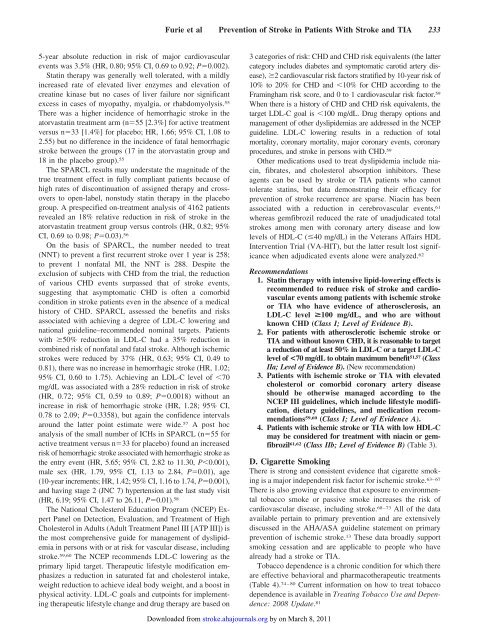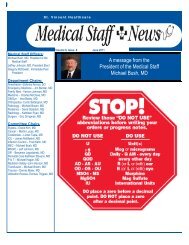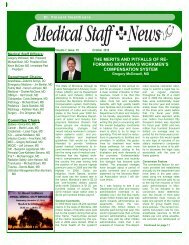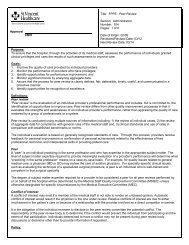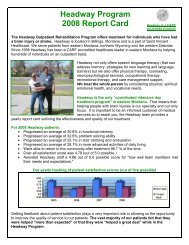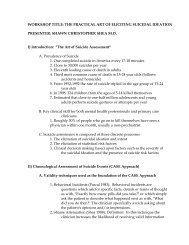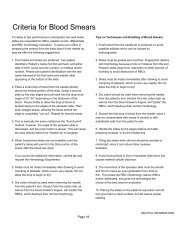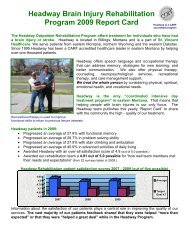AHA/ASA Guideline Guidelines for the Prevention of Stroke in ...
AHA/ASA Guideline Guidelines for the Prevention of Stroke in ...
AHA/ASA Guideline Guidelines for the Prevention of Stroke in ...
You also want an ePaper? Increase the reach of your titles
YUMPU automatically turns print PDFs into web optimized ePapers that Google loves.
Furie et al <strong>Prevention</strong> <strong>of</strong> <strong>Stroke</strong> <strong>in</strong> Patients With <strong>Stroke</strong> and TIA 2335-year absolute reduction <strong>in</strong> risk <strong>of</strong> major cardiovascularevents was 3.5% (HR, 0.80; 95% CI, 0.69 to 0.92; P0.002).Stat<strong>in</strong> <strong>the</strong>rapy was generally well tolerated, with a mildly<strong>in</strong>creased rate <strong>of</strong> elevated liver enzymes and elevation <strong>of</strong>creat<strong>in</strong>e k<strong>in</strong>ase but no cases <strong>of</strong> liver failure nor significantexcess <strong>in</strong> cases <strong>of</strong> myopathy, myalgia, or rhabdomyolysis. 55There was a higher <strong>in</strong>cidence <strong>of</strong> hemorrhagic stroke <strong>in</strong> <strong>the</strong>atorvastat<strong>in</strong> treatment arm (n55 [2.3%] <strong>for</strong> active treatmentversus n33 [1.4%] <strong>for</strong> placebo; HR, 1.66; 95% CI, 1.08 to2.55) but no difference <strong>in</strong> <strong>the</strong> <strong>in</strong>cidence <strong>of</strong> fatal hemorrhagicstroke between <strong>the</strong> groups (17 <strong>in</strong> <strong>the</strong> atorvastat<strong>in</strong> group and18 <strong>in</strong> <strong>the</strong> placebo group). 55The SPARCL results may understate <strong>the</strong> magnitude <strong>of</strong> <strong>the</strong>true treatment effect <strong>in</strong> fully compliant patients because <strong>of</strong>high rates <strong>of</strong> discont<strong>in</strong>uation <strong>of</strong> assigned <strong>the</strong>rapy and crossoversto open-label, nonstudy stat<strong>in</strong> <strong>the</strong>rapy <strong>in</strong> <strong>the</strong> placebogroup. A prespecified on-treatment analysis <strong>of</strong> 4162 patientsrevealed an 18% relative reduction <strong>in</strong> risk <strong>of</strong> stroke <strong>in</strong> <strong>the</strong>atorvastat<strong>in</strong> treatment group versus controls (HR, 0.82; 95%CI, 0.69 to 0.98; P0.03). 56On <strong>the</strong> basis <strong>of</strong> SPARCL, <strong>the</strong> number needed to treat(NNT) to prevent a first recurrent stroke over 1 year is 258;to prevent 1 nonfatal MI, <strong>the</strong> NNT is 288. Despite <strong>the</strong>exclusion <strong>of</strong> subjects with CHD from <strong>the</strong> trial, <strong>the</strong> reduction<strong>of</strong> various CHD events surpassed that <strong>of</strong> stroke events,suggest<strong>in</strong>g that asymptomatic CHD is <strong>of</strong>ten a comorbidcondition <strong>in</strong> stroke patients even <strong>in</strong> <strong>the</strong> absence <strong>of</strong> a medicalhistory <strong>of</strong> CHD. SPARCL assessed <strong>the</strong> benefits and risksassociated with achiev<strong>in</strong>g a degree <strong>of</strong> LDL-C lower<strong>in</strong>g andnational guidel<strong>in</strong>e–recommended nom<strong>in</strong>al targets. Patientswith 50% reduction <strong>in</strong> LDL-C had a 35% reduction <strong>in</strong>comb<strong>in</strong>ed risk <strong>of</strong> nonfatal and fatal stroke. Although ischemicstrokes were reduced by 37% (HR, 0.63; 95% CI, 0.49 to0.81), <strong>the</strong>re was no <strong>in</strong>crease <strong>in</strong> hemorrhagic stroke (HR, 1.02;95% CI, 0.60 to 1.75). Achiev<strong>in</strong>g an LDL-C level <strong>of</strong> 70mg/dL was associated with a 28% reduction <strong>in</strong> risk <strong>of</strong> stroke(HR, 0.72; 95% CI, 0.59 to 0.89; P0.0018) without an<strong>in</strong>crease <strong>in</strong> risk <strong>of</strong> hemorrhagic stroke (HR, 1.28; 95% CI,0.78 to 2.09; P0.3358), but aga<strong>in</strong> <strong>the</strong> confidence <strong>in</strong>tervalsaround <strong>the</strong> latter po<strong>in</strong>t estimate were wide. 57 A post hocanalysis <strong>of</strong> <strong>the</strong> small number <strong>of</strong> ICHs <strong>in</strong> SPARCL (n55 <strong>for</strong>active treatment versus n33 <strong>for</strong> placebo) found an <strong>in</strong>creasedrisk <strong>of</strong> hemorrhagic stroke associated with hemorrhagic stroke as<strong>the</strong> entry event (HR, 5.65; 95% CI, 2.82 to 11.30, P0.001),male sex (HR, 1.79, 95% CI, 1.13 to 2.84, P0.01), age(10-year <strong>in</strong>crements; HR, 1.42; 95% CI, 1.16 to 1.74, P0.001),and hav<strong>in</strong>g stage 2 (JNC 7) hypertension at <strong>the</strong> last study visit(HR, 6.19; 95% CI, 1.47 to 26.11, P0.01). 58The National Cholesterol Education Program (NCEP) ExpertPanel on Detection, Evaluation, and Treatment <strong>of</strong> HighCholesterol <strong>in</strong> Adults (Adult Treatment Panel III [ATP III]) is<strong>the</strong> most comprehensive guide <strong>for</strong> management <strong>of</strong> dyslipidemia<strong>in</strong> persons with or at risk <strong>for</strong> vascular disease, <strong>in</strong>clud<strong>in</strong>gstroke. 59,60 The NCEP recommends LDL-C lower<strong>in</strong>g as <strong>the</strong>primary lipid target. Therapeutic lifestyle modification emphasizesa reduction <strong>in</strong> saturated fat and cholesterol <strong>in</strong>take,weight reduction to achieve ideal body weight, and a boost <strong>in</strong>physical activity. LDL-C goals and cutpo<strong>in</strong>ts <strong>for</strong> implement<strong>in</strong>g<strong>the</strong>rapeutic lifestyle change and drug <strong>the</strong>rapy are based on3 categories <strong>of</strong> risk: CHD and CHD risk equivalents (<strong>the</strong> lattercategory <strong>in</strong>cludes diabetes and symptomatic carotid artery disease),2 cardiovascular risk factors stratified by 10-year risk <strong>of</strong>10% to 20% <strong>for</strong> CHD and 10% <strong>for</strong> CHD accord<strong>in</strong>g to <strong>the</strong>Fram<strong>in</strong>gham risk score, and 0 to 1 cardiovascular risk factor. 59When <strong>the</strong>re is a history <strong>of</strong> CHD and CHD risk equivalents, <strong>the</strong>target LDL-C goal is 100 mg/dL. Drug <strong>the</strong>rapy options andmanagement <strong>of</strong> o<strong>the</strong>r dyslipidemias are addressed <strong>in</strong> <strong>the</strong> NCEPguidel<strong>in</strong>e. LDL-C lower<strong>in</strong>g results <strong>in</strong> a reduction <strong>of</strong> totalmortality, coronary mortality, major coronary events, coronaryprocedures, and stroke <strong>in</strong> persons with CHD. 59O<strong>the</strong>r medications used to treat dyslipidemia <strong>in</strong>clude niac<strong>in</strong>,fibrates, and cholesterol absorption <strong>in</strong>hibitors. Theseagents can be used by stroke or TIA patients who cannottolerate stat<strong>in</strong>s, but data demonstrat<strong>in</strong>g <strong>the</strong>ir efficacy <strong>for</strong>prevention <strong>of</strong> stroke recurrence are sparse. Niac<strong>in</strong> has beenassociated with a reduction <strong>in</strong> cerebrovascular events, 61whereas gemfibrozil reduced <strong>the</strong> rate <strong>of</strong> unadjudicated totalstrokes among men with coronary artery disease and lowlevels <strong>of</strong> HDL-C (40 mg/dL) <strong>in</strong> <strong>the</strong> Veterans Affairs HDLIntervention Trial (VA-HIT), but <strong>the</strong> latter result lost significancewhen adjudicated events alone were analyzed. 62Recommendations1. Stat<strong>in</strong> <strong>the</strong>rapy with <strong>in</strong>tensive lipid-lower<strong>in</strong>g effects isrecommended to reduce risk <strong>of</strong> stroke and cardiovascularevents among patients with ischemic strokeor TIA who have evidence <strong>of</strong> a<strong>the</strong>rosclerosis, anLDL-C level >100 mg/dL, and who are withoutknown CHD (Class I; Level <strong>of</strong> Evidence B).2. For patients with a<strong>the</strong>rosclerotic ischemic stroke orTIA and without known CHD, it is reasonable to targeta reduction <strong>of</strong> at least 50% <strong>in</strong> LDL-C or a target LDL-Clevel <strong>of</strong>


